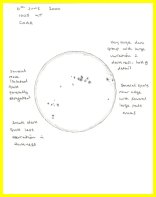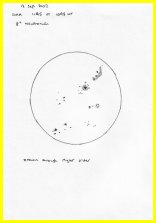

Select an image to view enlargements
Click here for one observer's story of the Solar eclipse 1999
Observing the Sun is a very civilised part of astronomy - it's done in broad daylight. It is also the most potentially dangerous. Never look directly at the Sun, especially through any sort of optical aid, be it binoculars, telescope or camera lens. By the time you realise harm has been done your eyesight could be permanently damaged.
The drawings above used two different safe methods of observation. The one to the left was done by projecting the eyepiece image onto a piece of paper held at the focus of the eyepiece. The one to the right was observed directly through a Mylar filter. The image observed through the filter shows more fine detail, as one would expect, but projecting the image is a much easier, far cheaper and ultimately safer option.
Both images show groups of sun spots. Sun spots are caused by magnetic activity in the Sun, and the more magnetic activity the more sun spots. In theory the activity cycles from a minimum to a maximum and back to minimum again, so you would expect the occurence of sun spots to be the same, but it doesn't always follow.